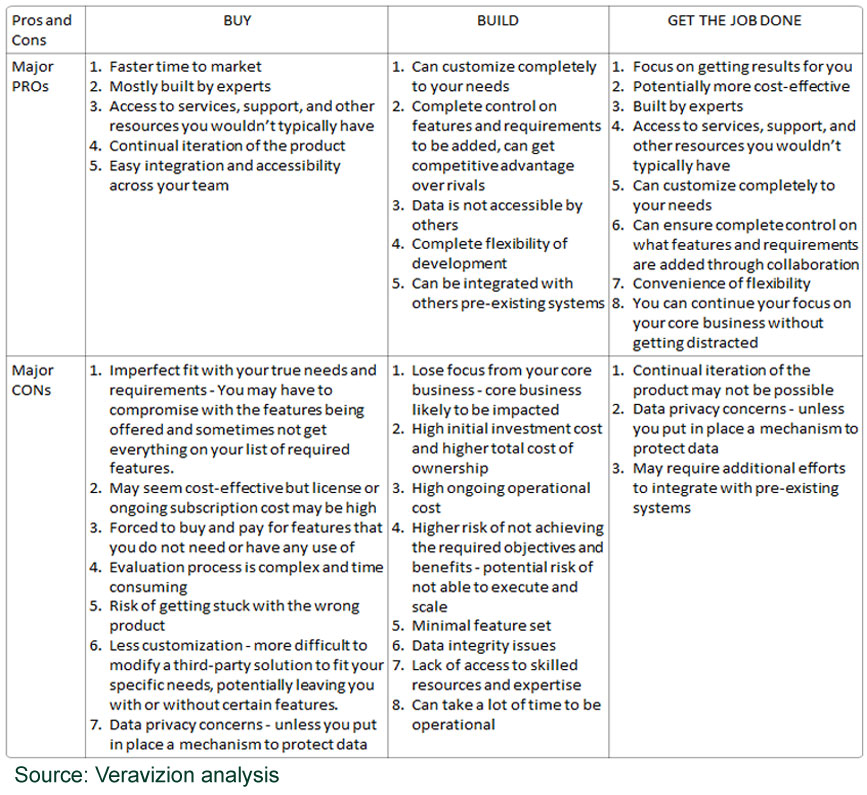2 015 arrives on a promising note for analytics – both as a technology and as an industry. 2014 proved favorable for analytics in getting wider acknowledgement as a serious strategy to adopt for long term competitive advantage. In that sense, 2014 was the year of acceptance and 2015 augurs to be the year of growth.
In this paper, we take note of the emerging trends in analytics with a pointed focus on their applicability to SME businesses. We began by collecting the trends data released by leading publishers. Our analysis of the aggregated information revealed some interesting bytes about the direction of these trends. Here we share with you our own perspectives on the top trends predicted by the external industry experts.
SMEs embrace analytics to deepen customer understanding.
More businesses are starting to anticipate their customers’ needs and act on it proactively. Personalization is the key. New technological advancement is making it possible to allow metrics to be tracked across even more areas for each customer, thus enabling SMEs to understand their profitable customers like never before. More screen time per consumer is creating even more data to be analysed and mined for deeper insights. Smart SME businesses looking for growth and customer loyalty are going all out to invest in cost-effective analytics solutions to get closer to their customers, drive cost efficiencies, and improve their product and service offerings. Larger organizations are implementing it to improve their customer service and call centre processes. B2C businesses like the consumer product, retail, and wholesale companies predict the fastest growth in the use of analytics to help improve customer insights and meet real-time customer demands. SMEs are implementing analytics to transform their marketing approach to connect with more prospects and customers, to provide them with the right information at the right time in their buying journey, and to create favourable perceptions about their offerings. After all Marketing is a battle of perceptions, not products.
Use of customized analytics becomes pervasive.
More and more human actions are generating Exabytes of data today. To get a sense of the amount of data, let’s just say that we will need around 50 billion trees made into paper to print 1 Exabyte of data. That’s roughly 9 huge stacks of papers, each touching Mars from Earth. So we now have developed massive capability of data generation; and the rate is only increasing with the advent of wearables, smart machines, and the ‘Internet of Things’. But this enormous amount of data will be of no use if not analysed and utilized appropriately. Anytime anywhere analytics will be the only way forward to satisfy the pressing need to analyse this vast pools of structured and unstructured data inside and outside the enterprise. Data analytics will soon become so ubiquitous that it will be deeply and invisibly embedded everywhere.
For SMEs looking to break away, micro-segmentation and micromarketing at the consumer level can provide a big competitive advantage. You can’t compete, if you don’t have competitive advantage. Information week survey reveals that there is fall in the trend to standardize analytics. For SMEs, this means they are not seeing competitive advantage in standardized analytics products. Instead, more companies are now hiring customized analytics to satisfy their unique needs. SMEs across all industries cited ‘ensuring information accuracy and reliability’ as a top concern. 2015 is likely to see a democratization of data throughout the organization, meaning that more departments will become adept at using the insights generated by experts. Day-to-day activities will be based on data and the insights created from it.
Rise of sensor-originated data from wearables and the ‘Internet of things’.
Wiki defines the Internet of Things (or IoT) as the interconnection of uniquely identifiable embedded computing devices within the existing Internet infrastructure. For example, your smart watch continuously measuring your pulse while you are running, and prompting you to stop when it senses that your pulse is beating abnormally. The ‘internet of things’ has facilitated the innovation of wearables that can capture data using sensors and communicate it instantly over the internet. A few examples of wearables are fitness trackers, heart rate monitors, and smart watches. These wearables and IoTs will empower humans to take predictive (not just proactive) actions in a timely manner. The sensor based data collection will further boost application of analytics to analyse all these data. However, in the context of wearables and IoT, we are still in the stage of figuring out its possible real-life applications to individuals and businesses. In 2015, the IoT is expected to venture beyond wearables into your homes and surroundings.
Cloud becomes main-stream with greater cloud-based ecosystem.
Cloud has already crossed the stage that IoT is currently in. It has made deep inroads into datacentres, data warehouses, centralized storages, and servers. The cloud ecosystem is likely to penetrate further with the growth of centrally coordinated applications being hosted on cloud infrastructures around the world. 2015 will see horizontal spread of cloud-usage in device convergence and application portability across devices. Strictly focusing on SMEs, companies like Amazon and Google have rapidly matured their cloud-based offerings to SMEs with freemium and usage based models. However, monetization models of cloud based services remain complex. Despite that, cloud adoption is likely to increase among larger businesses as they strive to contain their infrastructure costs. Whereas the smaller businesses will (and probably should) expect the cloud-offerings to improve in terms of security, pricing-models, understanding of its benefits, and real ROI, before jumping the cloud bandwagon.
Better acceptance of open source technology like Hadoop and NoSQL databases.
If there is one trend which has high standard deviation with its long term sustainability, we believe it is this one. Hadoop is becoming popular because of “its ability to store and process semi-structured, unstructured, and variable data”. With the burgeoning unstructured data (from social media), it is no surprise that Hadoop is getting good acceptance among (larger) customers. But we hasten to add that Hadoop and NoSQL may not be in the priority list of most SMEs, simply because SMEs, unlike larger companies, have a tight purse to operate. They already have other higher priority strategies to undertake leaving not much scope for investment in the likes of Hadoop. It would be interesting to monitor and track how this trend pans out in the months to come.
SMEs will incorporate mobile-based solutions in their IT strategy.
A mobile phone is nothing short of a computer these days. Every passing month, millions of consumers are switching to a smart phone and relying on it for their daily chores. Referring a to-do list, searching for a Thai restaurant in the vicinity, buying books or fashion garments, downloading songs, and pretty much every other activity is increasingly shifting to a mobile device. Companies are also reinforcing their online presence with mobile-based solutions. The sale of phablets is likely to grow to 60%; thus SMEs will find it prudent to be in tune with this trend in order to be able to tap tech-savvy consumers.
Optimizing business gains from social media presence.
Businesses see social media as a mechanism to attract more customers, create buzz about their products and services, seek feedback to better customer service, and improve service offerings. Many SMEs seem to employ social media in a disorganized manner rather than design a systematic campaign to deploy a social media strategy for say, digital marketing. They hope that it will help them in some way. Hope is rarely a good strategy. In the coming year, SMEs are likely to rely on social media rather than just use it. However they seem to lack the means or resources to measure the gains from their social media strategy. This is where professional services firms can assist in devising a well-planned strategy to leverage real gains from social media.
Integration woes.
Frankly, we are as surprised (or unsurprised) to see integration woes as an ongoing trend as you possibly are. If there is one trend that has continued over decades, it is this one. Over the years, the ‘entities’ to be integrated have changed but the integration-related troubles continue. In the 1980s and 1990s, integration of legacy systems with open systems gave pain. In the 2000s, integration of different software architectures was cause for grief. Today, analytics tools and techniques are being developed around the Internet of Things, but the integration of these systems is lagging. More specifically for SMEs wanting to embrace analytics, integration of structured, semi-structured, and unstructured data is a source of much anguish. Worse, they typically lack the expertise and resources to manage the entire integration process despite employing a team of analysts. This is another reason that in-house analytics teams are increasingly not being preferred because of the need of specialist treatments of data.
Data security and privacy concerns.
Data privacy and security concern has been one of the main reasons keeping SMEs from adopting analytics. All roads to meaningful business insights lead through your data. You need to share data with analysts and service providers in order to get hidden insights that can be utilized for business benefits. However, SMEs have been wary in sharing their data, probably rightly so, in order to protect their customer identities, even at the cost of losing their competitive advantage to rivals. But now, with increasing number of SMEs taking up analytics to secure and grow their businesses, others don’t want to be left behind. Organizations will increasingly recognize that it is not possible to operate in a 100 percent secured environment. Once organizations acknowledge that, they can begin to apply more-sophisticated risk assessment and mitigation tools. They will look to embed security at multiple levels viz. application-level, execution-level, storage-level, and even contract-level. Interestingly, analytics itself is proving to be a great mechanism for security breach prevention.
Organizations moving away from in-house analytics.
Organizations hired staff to set-up their own in-house analytics teams primarily for two reasons: First, they intended to take up analytics as an ongoing business strategy and thought that hiring in-house analysts was the inexpensive way to achieving that objective. Second, they were guarded about sharing data with external service providers. The arrangement of in-house analytics department should have worked had it consisted of the right skilled-resources, such as data scientists and analytics experts, who came from analytics background. In many cases, these data analysts might have delivered some initial benefits despite coming from the business-side. However, companies seem to have realized that they are spending way too high to achieve that purpose. Not only do they not have the ‘right-skilled’ resources to take up the ongoing analytics challenges, but it also takes their focus away from their core business. Moreover, setting up an in-house analytics team is a costly and risky proposition requiring the necessary infrastructure to operate. Therefore, SMEs seem to be moving away from heavy in-house big data infrastructure to external analytics service providers. In some cases, they are even going for big data-as-a-service in the cloud. This allows them to have a lean in-house analytics team of just analytics officers or data officers and get their stuff done through the external knowledge workers.
In sum, most trends are pointing toward ‘ubiquity of analytics in business’. Which of these trends will realize in a big way in 2015? Our guess is as good as yours! Meanwhile, we would love to know your thoughts on how analytics has contributed to your business in 2014, and more importantly how do you perceive it to perform this year. Please do share!
Related Posts:
<– Buy, Build, or Get the job done?
Most important thing in analytics is not what you think –>
You can also subscribe to our blog – Our Perspectives – to receive interesting articles and tips in email. We would love to read your perspectives and comments on that.
Do follow Veravizion on LinkedIn, Twitter, Facebook, or Google+ to receive easy updates.







